Standing at the crossroads of Europe and Asia, Turkey is a mesmerizing fusion of cultures, flavors, and histories. It’s where the East meets the West, creating a dynamic blend of traditions that make every corner of the country feel like a new discovery.
From the scent of spices in bustling bazaars to the grandeur of Ottoman palaces, from ancient ruins to surreal landscapes, Turkey offers a sensory experience unlike any other. This 10-day Turkey itinerary captures the essence of this beautiful country, allowing you to explore its diverse offerings.
Beyond its lively cities and historic mosques, Turkey’s landscapes are equally captivating. Inland, ancient wonders whisper stories of Cleopatra, Mark Antony, Caesar, and Alexander the Great—yet many of these sites remain untouched compared to their counterparts in Italy and Greece.
Meanwhile, traditional wooden gulets sail through crystal-clear waters along the Turquoise Coast, stopping in secluded bays where time seems to stand still. Fishing villages along the route, with blue-painted tables shaded by cascades of pink bougainvillaea, have remained unchanged for centuries, offering a glimpse into a way of life that has endured for generations.
Whether it’s exploring Istanbul’s rich past, floating above Cappadocia’s fairy chimneys in a hot air balloon, or sailing through the Aegean’s hidden coves, Turkey is a land of contrasts and endless adventure.
Turkey had been on my travel radar for a while, and when I finally spent ten days exploring it, the experience was nothing short of unforgettable. This country isn’t just about beautiful beaches and luxury resorts—it’s a mix of ancient ruins, surreal landscapes, and vibrant cities that make every moment an adventure.
I made my way across Turkey using buses, trains, and domestic flights, and I’ll be sharing all the details on transportation, stays, and must-see spots in this guide. If you’re planning your own two-week adventure in Turkey, keep reading—I’ve got you covered!
How Long Should You Spend in Turkey?
The ideal Turkey itinerary really depends on how much time you have, but if you want to experience the country’s diverse landscapes, history, and culture, two weeks is perfect. This gives you enough time to explore iconic sites, soak in the local atmosphere, and travel between regions without feeling rushed.
If you’re working with 10 days, you can still cover a lot—focusing on major highlights like Istanbul, Cappadocia, and the Aegean coast. Even in just one week, you can have an unforgettable trip by picking two or three key destinations.
For those with three weeks, the possibilities expand even further. You could dive deeper into Istanbul’s rich history, explore lesser-visited ancient sites, or spend extra days along Turkey’s breathtaking coastline. A three-week itinerary could also include hiking the Lycian Way, a scenic coastal trail weaving through rugged mountains, pine forests, and traditional Turkish villages.
When Is the Best Time to Visit Turkey?
Turkey is a destination you can visit year-round, but the best time depends on the kind of experience you’re looking for. April, May, and September are widely considered the best months to explore, offering pleasant temperatures and fewer crowds.
Summer (June–August) brings intense heat, especially in inland areas like Cappadocia and Ephesus, making sightseeing a challenge. It’s also peak tourist season, so expect higher prices and busier attractions. Winter (December–February), on the other hand, can be surprisingly cold, with snowfall in Istanbul and Cappadocia transforming the landscapes into something truly magical but requiring extra layers.
Personally, I found September to be the perfect balance—fewer crowds, comfortable temperatures (18–25°C), and warm enough for both sightseeing and coastal relaxation. Whether you’re wandering through ancient ruins, taking a hot air balloon ride over Cappadocia, or sailing along the Turquoise Coast, the weather in September makes every experience even more enjoyable.
Getting Around Turkey
Traveling through Turkey is easier than I expected, thanks to its well-connected transport system. Whether hopping on a flight, catching a long-haul bus, or taking a scenic train ride, I found plenty of ways to get around smoothly.
Flying: The Fastest Way to Travel
With nearly 50 airports, flying across Turkey is quick and affordable. I managed to get cheap domestic flights, except during peak holiday seasons when prices shot up. From one end of the country to the other, it takes less than two hours—a huge time-saver.
I flew with:
- Turkish Airlines for the best coverage and service
- AnadoluJet & SunExpress for decent mid-range options
- Pegasus Airlines when I wanted a budget-friendly flight
Buses & Dolmuş: The Real Turkish Experience
Buses in Turkey run 24/7, and I quickly realized they’re the backbone of travel here. I took a few intercity coaches and was surprised to find reclining seats, snack service, and even Wi-Fi on some. Companies like Kamil Koç, Pamukkale, and Varan made long journeys comfortable, with rest stops at massive service areas that felt like shopping malls.
For shorter trips, I relied on dolmuş—shared minibuses that leave when full. They’re cheap, flexible, and a great way to experience local life.
Trains: Not the Fastest, But Worth It for the Views
While train travel in Turkey isn’t the quickest option, I found some hidden gems. The high-speed rail between Istanbul, Eskişehir, and Ankara was a smooth ride and a great alternative to flying. But my favorite train journey? The Doğu Ekspresi (Eastern Express) from Ankara to Kars—a slow, scenic ride through remote landscapes that felt straight out of a travel documentary.
Local trains run in cities like Izmir, Konya, and Adana, but I mostly stuck to buses and flights for efficiency.
Essential Tips for Traveling in Turkey
After spending time exploring Turkey, I picked up some essential travel tips that made my trip smoother. Here’s what you need to know before you go:
Check Visa Requirements in Advance
Turkey’s visa rules vary by nationality, so check entry requirements before booking your trip. I applied for my e-Visa online through the official Turkish government website, which was a quick and easy process. Make sure to do this ahead of time to avoid any last-minute issues.
Currency & Payments
Turkey uses the Turkish Lira (TL). ATMs are widely available, and most places accept credit cards, but I always kept some cash on hand for smaller shops, markets, and transportation. Exchange rates fluctuate, so I found it helpful to use a currency conversion app to stay updated.
Language & Communication
Turkish is the official language, but in major cities and tourist areas, many people in hotels, restaurants, and shops speak English. I also learned a few basic Turkish phrases, which locals really appreciated!
Get the Museum Pass
If you plan to visit multiple historical sites, the Museum Pass is a must-have. It covers entry to top attractions like Ephesus, Pamukkale, and major sites in Istanbul, saving both time and money. I bought mine online, but you can also get it at participating attractions.
Detailed 10 Day Turkey Itinerary
Day 1 Istanbul: Exploring City Highlights of Istanbul
No trip to Turkey is complete without starting in Istanbul—the heart of the country’s history and culture. Since it’s well-connected to Europe and beyond, it’s the easiest place to begin your adventure. But beyond convenience, Istanbul is a city that demands to be explored, with over 3,000 years of history and a skyline that blends minarets, domes, and modern high-rises.
I kicked off my trip in Sultanahmet, the city’s historic core, where some of Istanbul’s most iconic landmarks are just a short walk from each other. You can explore them at your own pace or join a walking tour to skip ticket lines and get insightful stories along the way. I’ve done both, and while wandering solo is great, a guided tour really brings the past to life.
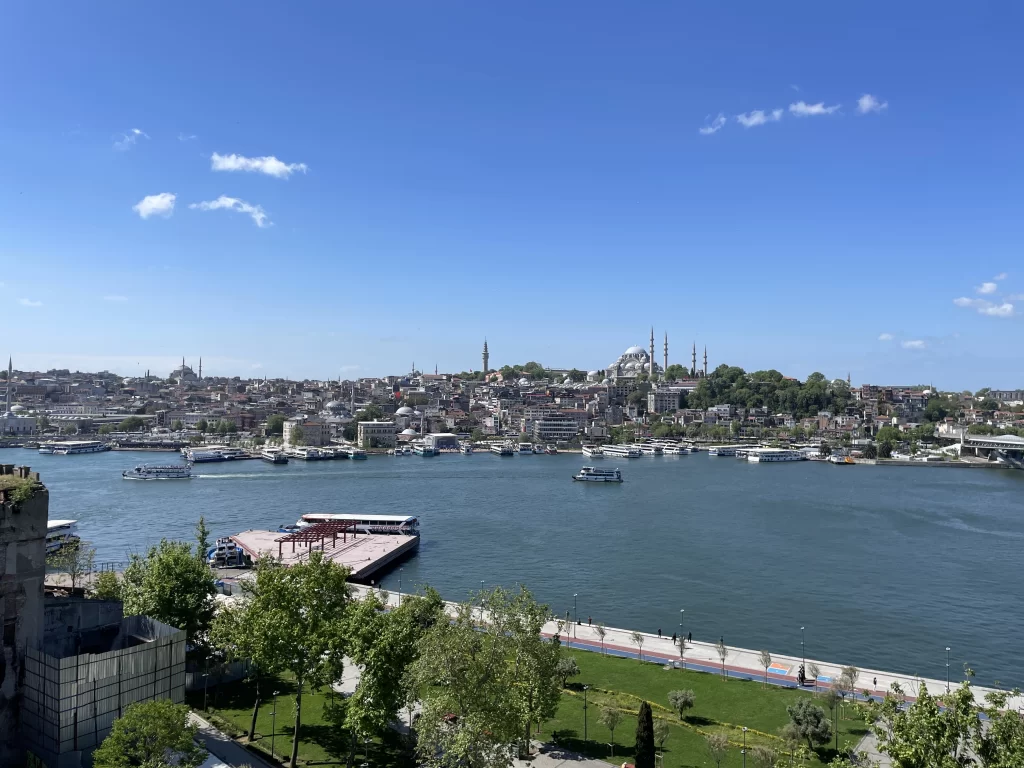
Blue Mosque (Sultan Ahmed Mosque)
My first stop was the Sultan Ahmed Mosque, better known as the Blue Mosque. It’s one of Istanbul’s most famous landmarks, and even though it’s an active place of worship, visitors are welcome outside of prayer times. The mosque’s towering domes, six minarets, and intricate blue Iznik tiles make it a must-see.
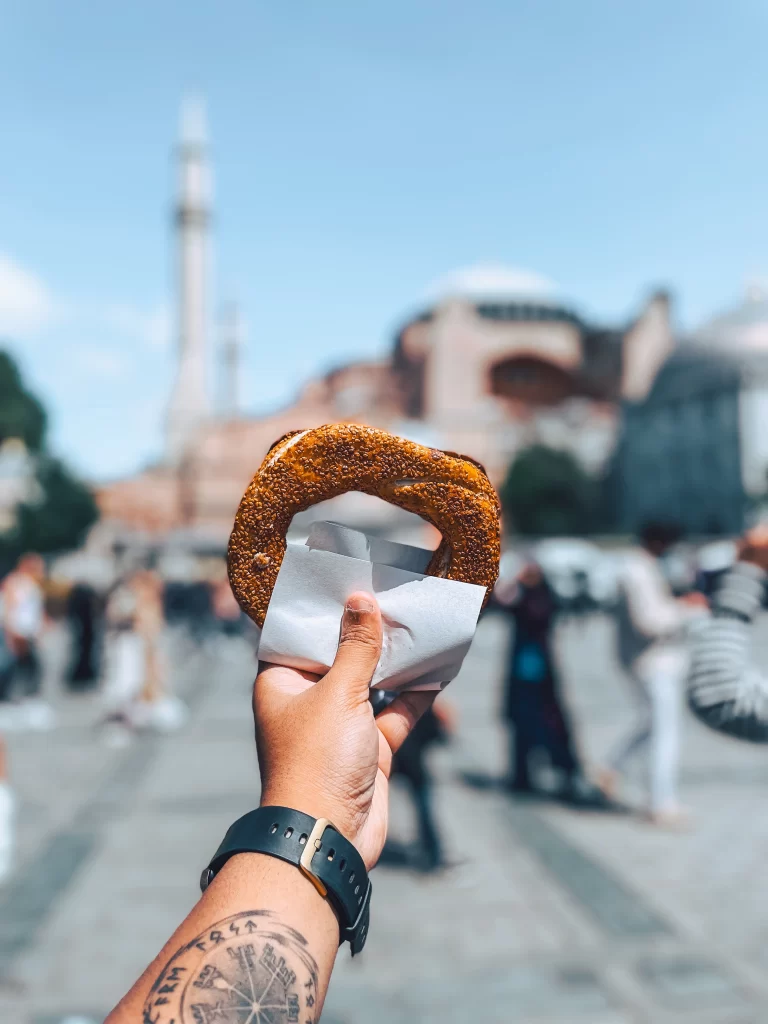
Hippodrome of Constantinople
Stepping outside, I found myself at the Hippodrome of Constantinople—a huge public space that once hosted chariot races and grand events during the Roman and Byzantine eras. Today, it’s a quiet square, but ancient monuments like the Egyptian Obelisk and Serpent Column still stand, whispering tales of Istanbul’s imperial past.
Basilica Cistern
Before heading to my next major stop, I took a detour underground to visit the Basilica Cistern—a massive, eerie water reservoir built during the Byzantine era. The soft glow of lights reflecting off the water, the towering columns, and the mysterious Medusa heads at the base of two pillars make this place feel almost otherworldly. It’s one of my favorite spots in the city.
Hagia Sophia
Just a few steps away is Hagia Sophia, an architectural marvel that has transformed over time from church to mosque to museum and back to a mosque again in 2020. Walking inside, I was struck by the mix of Islamic calligraphy alongside ancient Christian mosaics—a true representation of Istanbul’s layered history.
💡 Tip: As of 2024, tourists must pay an entry fee to visit Hagia Sophia. It remains open daily but closes during prayer times.
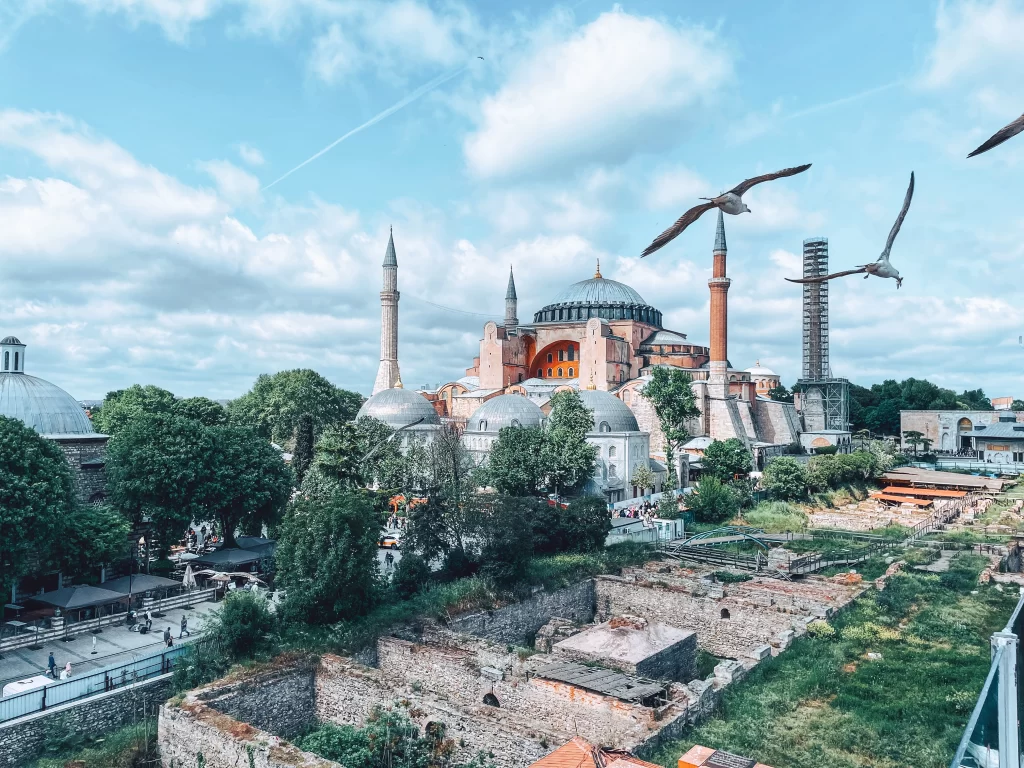
Topkapi Palace
I wrapped up my first day at Topkapi Palace, once the lavish residence of Ottoman sultans. The sprawling complex is filled with ornate courtyards, royal chambers, and breathtaking views of the Bosphorus. It’s also home to the Holy Relics Room, where you’ll find artifacts like Prophet Muhammad’s cloak and sword.
Day 2 Istanbul: Markets, Views & a Sunset on the Bosphorus
After a history-filled first day, my second day in Istanbul took me on a journey through bustling markets, panoramic city views, and a magical sunset cruise. This day was all about exploring Istanbul’s vibrant energy, indulging in its rich flavors, and experiencing its modern heartbeat.
Grand Bazaar – A Labyrinth of Treasures
I started my morning diving into the chaotic yet mesmerizing world of the Grand Bazaar. With over 4,000 shops spread across 61 streets, this market is a sensory overload—glittering lamps, handwoven carpets, delicate ceramics, and the rich scent of leather fill every corner. I wandered through the maze-like alleys, sipping on Turkish tea while haggling for a keepsake. If you’re looking for a memorable souvenir, this is the place to find it!
Süleymaniye Mosque – A Hidden Gem with Stunning Views
Next, I made my way to Süleymaniye Mosque, an Ottoman masterpiece from the 16th century. Unlike the more famous Blue Mosque, this one feels peaceful and less crowded. The interior is spacious and elegant, and from its courtyard, I soaked in one of the best panoramic views of Istanbul, stretching over the Golden Horn and the Bosphorus.
Spice Bazaar – A Burst of Color & Aroma
A short walk from Süleymaniye took me to the Spice Bazaar, also called the Egyptian Bazaar. The moment I stepped inside, I was hit with the intoxicating scents of saffron, sumac, cinnamon, and Turkish delights. This is the place to stock up on authentic spices, dried fruits, nuts, and teas—whether for yourself or as gifts.
Galata Tower – A View Worth the Climb
Crossing the Galata Bridge, I grabbed a balık ekmek (grilled fish sandwich) from one of the vendors near the waterfront—a must-try street food in Istanbul. Then, I faced the steep climb to Galata Tower. For those who prefer an easier route, the Tünel funicular—one of the world’s oldest subway lines—cuts down the effort.
Galata Tower itself is one of the best places to get a 360° view of Istanbul. From the top, I took in the cityscape—a blend of ancient mosques, modern skyscrapers, and the shimmering Bosphorus below.
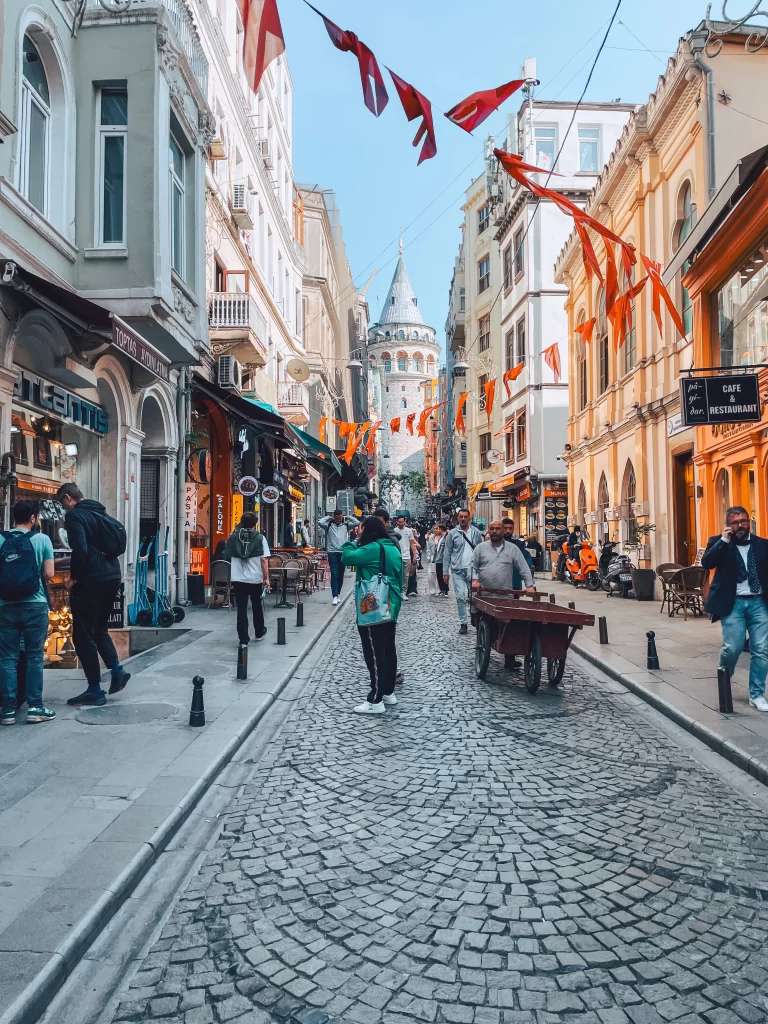
Taksim Square – The Pulse of Modern Istanbul
Heading further north, I arrived at Taksim Square, the heart of modern Istanbul. The square is always buzzing, surrounded by shops, restaurants, and the famous Istiklal Street, a lively pedestrian avenue filled with boutiques, street performers, and historic tram cars. I stopped for a quick cup of Turkish coffee, strong and thick, before continuing my journey.
Bosphorus Sunset Cruise – The Perfect End to the Day
After a full day of exploring, I was ready to unwind on the water. Taking a Bosphorus cruise at sunset was the perfect way to soak in the city from a different perspective. The boat gently floated past ornate Ottoman palaces, waterfront mansions, and the meeting point of Europe and Asia. As the sky turned shades of pink and gold, I sat back, sipping on tea, watching Istanbul’s skyline glow under the fading sunlight.
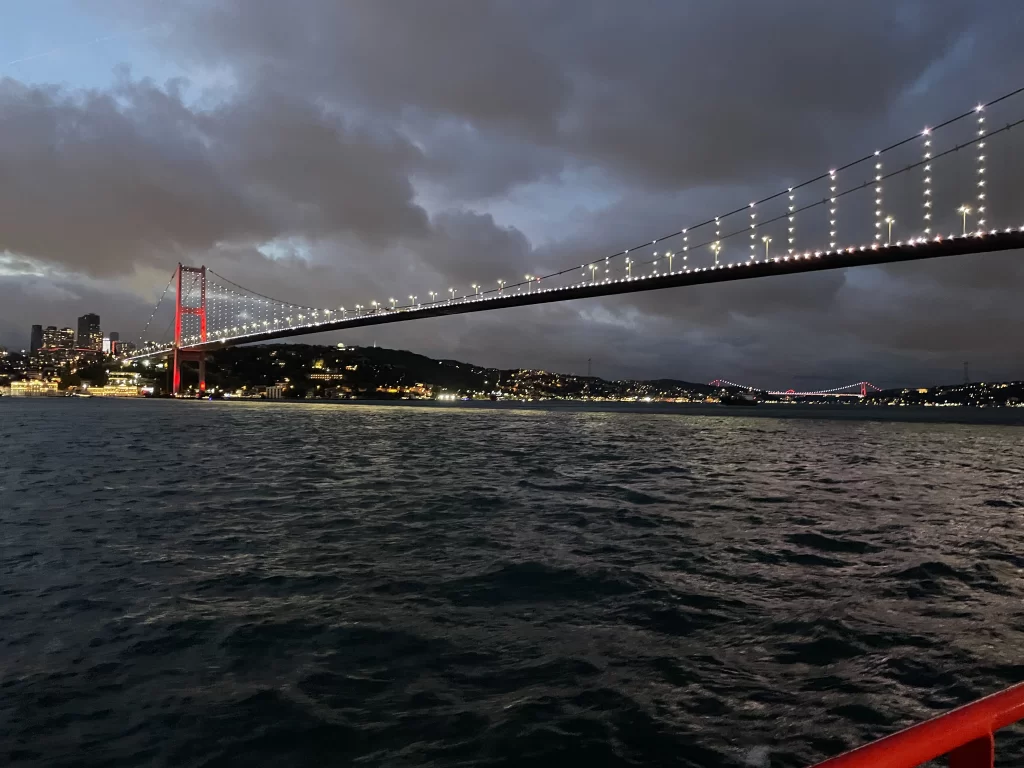
Day 3 Cappadocia: Spa Day + Open Aire Museum
Cappadocia is well-connected by both bus and train, making it an easy destination to reach. If you’re flying in, you have two airport options: Nevsehir Kapadokya Airport (NAV) and Kayseri Erkilet Airport (ASR). NAV is closer to Göreme, just a 40-minute drive, while ASR takes about an hour. I personally flew into NAV and departed from ASR since ticket prices varied significantly—something worth checking before booking your flights!
A Surprise Farm-to-Table Experience
Checking into my hotel came with an unexpected bonus: a complimentary farm-to-table breakfast and a scenic mini-hike. An open-air tractor transported us to the hotel’s private farm, where we walked down to a peaceful garden setting. Freshly prepared Turkish breakfast awaited, surrounded by wandering farm animals and breathtaking valley views. It was an authentic, slow-living moment I hadn’t anticipated—but one I wouldn’t have missed for anything.

Afternoon of Relaxation & History
After a laid-back afternoon at the hotel pool, I set out for the Göreme Open Air Museum, a short 20-minute walk away. As one of Turkey’s first UNESCO World Heritage sites, this open-air museum showcases ancient rock-cut churches, monasteries, and chapels—each carved into Cappadocia’s signature soft volcanic rock.
Pro Tip: If you’re visiting in summer, plan your trip for early morning or late afternoon to avoid the intense heat and heavy crowds.
Day 4 in Cappadocia: Hot Air Balloon Ride & The Red Tour
If there’s one experience that defines Cappadocia, it’s the hot air balloon ride. Since flights can get canceled due to unpredictable weather—especially wind—it’s best to schedule your ride early in your trip. That way, if it gets postponed, you still have time to rebook. I’ve heard stories of travelers spending three days in Cappadocia only to leave without ever taking flight—definitely not something you want to risk!
Pro Tip: Get the Best View
Once you’re in the basket, positioning matters. Try to secure a spot along the outer edge rather than near the balloon operator. While every angle offers breathtaking views, being on the edge makes it easier to snap those perfect in-flight photos. I learned this the hard way!
By 6:30-7:00 AM, the ride wraps up, just in time to head back to the hotel for breakfast and a quick recharge before the next adventure: The Red Tour.
Why I Chose the Red Tour Over the Green Tour
Initially, I planned to do both the Red and Green Tours, but after some research, I realized they cover a lot of similar sights. The Red Tour made more sense since it focuses on key spots closer to Göreme, while the Green Tour involves longer travel times with fewer stops.
If you’re short on time or just want a more efficient itinerary, I’d highly recommend prioritizing the Red Tour. It gives you a great mix of history, landscapes, and iconic Cappadocia scenery—all without spending hours on the road.
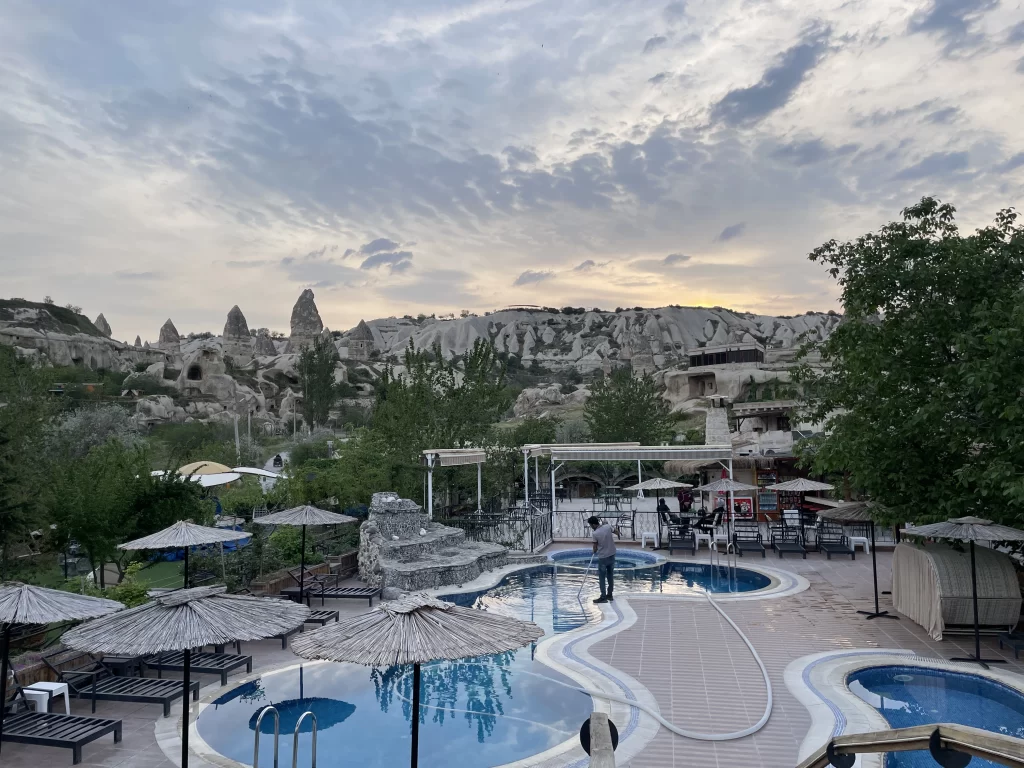
Day 5 in Cappadocia: A Self-Guided Green Tour by Car
The day started early—4:30 AM, to be exact. I made my way to the hotel rooftop, coffee in hand, to watch the sky come alive with hundreds of hot air balloons floating over Cappadocia’s surreal landscape. Even if you don’t take a ride, this is a must-see moment.
Initially, I had planned to join both the Red and Green Tours, but after reviewing the itineraries, I realized there were too many overlapping stops. Instead, I decided to rent a car and explore at my own pace. This turned out to be the best decision! It gave me the flexibility to move freely, skip the crowds, and spend extra time at the spots I found most fascinating.
Not comfortable driving? No worries! I noticed plenty of local companies offering customized private tours if you prefer a hassle-free experience.
First Stop: Ihlara Valley
From Göreme, I drove 1.5 hours to Ihlara Valley, a lush canyon carved by the Melendiz River. This was the perfect place to slow down, hike, and take in the natural beauty.
- Entrance Fee: 200 Turkish Liras (includes multiple entry/exit + Selime Monastery access)
- Hiking Distance: If you’re on a guided tour, you’ll hike a short section before stopping for lunch by the river in Belisirma. But if you’re driving yourself, keep in mind that completing the full trail is a 6-mile round trip, which takes around 5 hours.
Day 6 in Cappadocia: Exploring Göreme & a Sunset Camel Ride
For my last day in Cappadocia, I kept things easy and unplanned—a chance to soak in the town’s charm, explore local shops, and end the trip with a sunset camel ride through Rose Valley.
Wandering Through Göreme: Carpets, Ceramics & Antiques
I spent the morning strolling through Göreme, popping into antique shops and ceramic studios, admiring the intricate Turkish craftsmanship. One stop I couldn’t miss was Galerie Ikman, the famous handmade rug store. The place was even more stunning in person, with walls and floors covered in rich, colorful carpets. I managed to snap some incredible photos, but here’s something to note—they charge a fee for content creation. Prices vary depending on whether you rent an outfit, use a drone, or bring a photographer, so if you’re planning a shoot, be prepared for that!
A Sunset Ride Through Rose Valley
As the day wound down, I headed out for one last adventure—a sunset camel ride through Rose Valley. Riding through the otherworldly rock formations as the setting sun painted the sky in shades of pink and orange was a surreal experience. The slow, rhythmic movement of the camel made it feel like stepping back in time, and for a moment, I just let myself take it all in.
Day 7 in Antalya: Strolling Through History
Antalya, perched along the Turkish Riviera, is the kind of place where you could spend weeks exploring and still feel like you’ve only scratched the surface. With its mix of stunning beaches, rich history, and vibrant culture, it’s the perfect blend of relaxation and adventure.
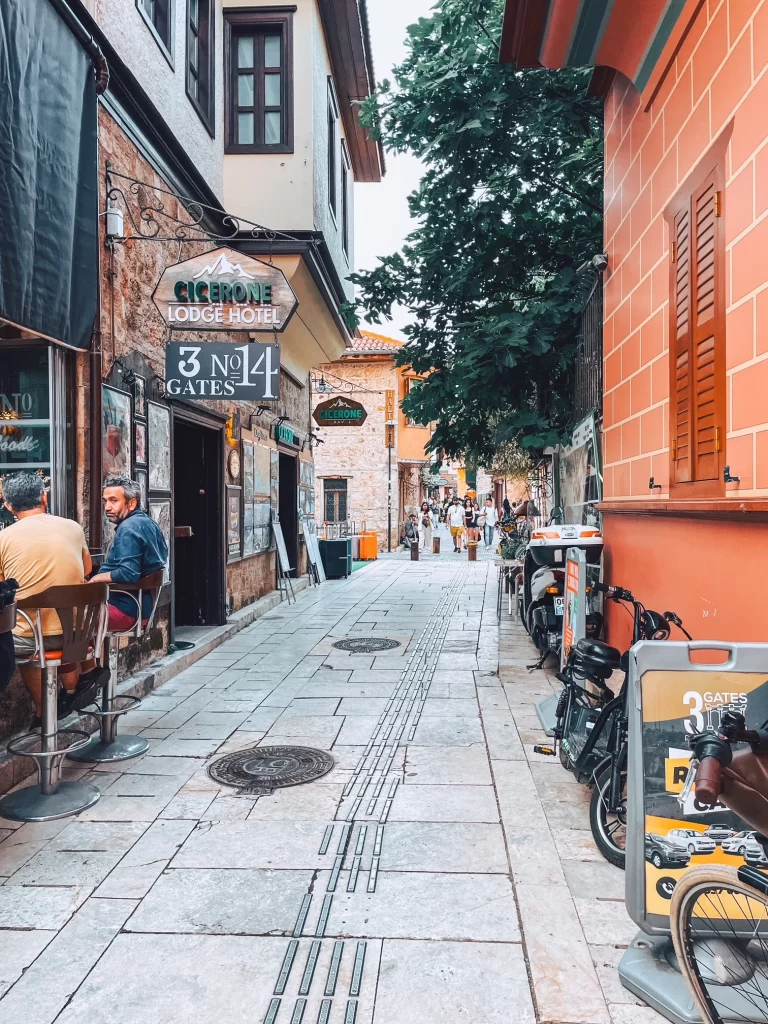
Morning: Exploring Kaleiçi – The Heart of Antalya
I started the day in Kaleiçi, Antalya’s Old Town, where cobbled streets wind through a maze of historic buildings, charming cafés, and hidden courtyards. Staying in this area was a game-changer—it put everything within walking distance and let me soak in the city’s unique atmosphere.
After a leisurely breakfast at my hotel, I made my way to Hadrian’s Gate, an impressive stone arch built in 130 CE to honor Roman Emperor Hadrian’s visit. Walking through its grand arches felt like stepping back in time. From there, I wandered deeper into the Old Town, where every turn revealed something new—quaint souvenir shops, centuries-old mosques, and buzzing restaurants filled with locals and tourists alike.
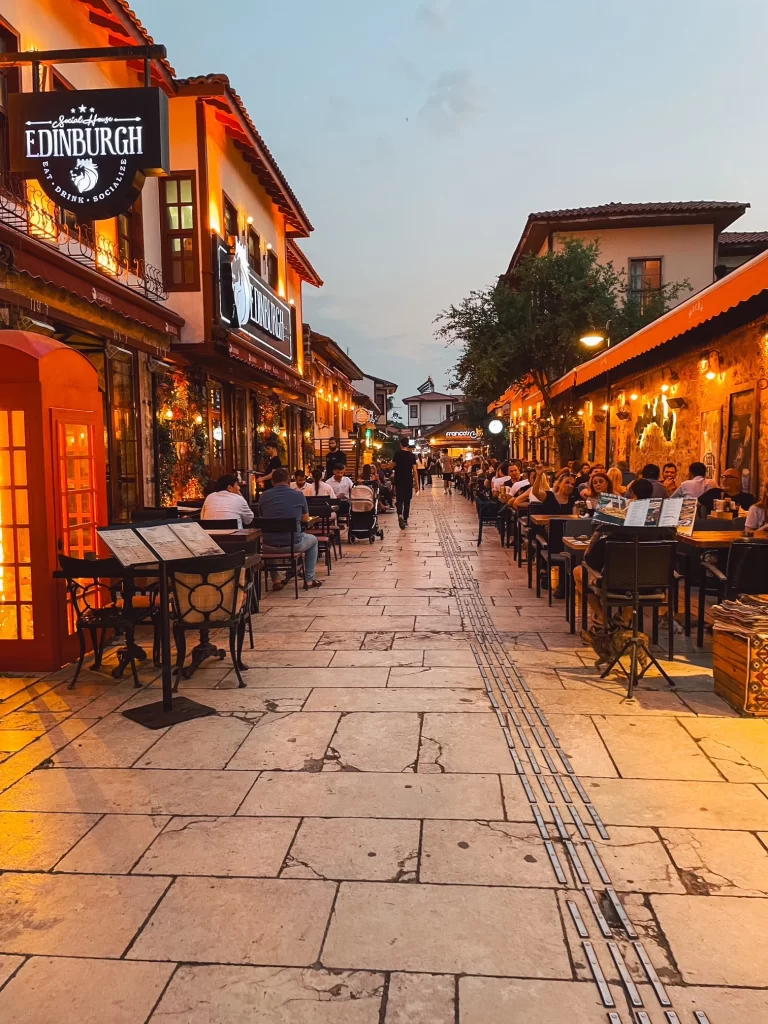
Some of my favorite stops:
- Yivli Minare Mosque – A striking 13th-century minaret, covered in colorful tiles, that stands as one of Antalya’s most iconic landmarks.
- Saat Kulesi (Clock Tower) – A historic timepiece gifted by German Kaiser Wilhelm II to the Ottoman Sultan Abdul Hamid, adding a unique touch to the town’s skyline.
- Hidirlik Tower – A 2nd-century stone watchtower offering stunning views where the city walls meet the Mediterranean Sea.
Midday: A Scenic Break at Karaalioglu Park
By midday, I was ready for a break, so I headed to Karaalioglu Park. Sitting on the stone wall overlooking Antalya’s cliffs and the deep blue Mediterranean, I soaked in the views while enjoying a refreshing drink from a nearby café.
Afternoon: Waterfalls or Art? Your Choice!
With half the day still ahead, I had time for one more adventure. Depending on your interests, here are two great options:
- Nature Lovers: Visit Düden Falls, where powerful cascades tumble straight into the sea. The Lower Düden Falls were my favorite—standing by the cliffs and watching the water crash into the Mediterranean was absolutely mesmerizing.
- Art Enthusiasts: Head to Sandland, an open-air museum featuring intricate sand sculptures crafted by artists from around the world. The level of detail is mind-blowing!
Day 8 in Antalya: Discovering Beaches
With 640 km of coastline, Antalya is a dream for beach lovers. I don’t always seek out beaches, but every now and then, I crave that calm, sun-soaked escape—and Antalya has plenty of stunning options.
While there are city beaches like Mermerli and Lara, the real gems lie a little further out. I spent the day beach-hopping, and here are my top picks:
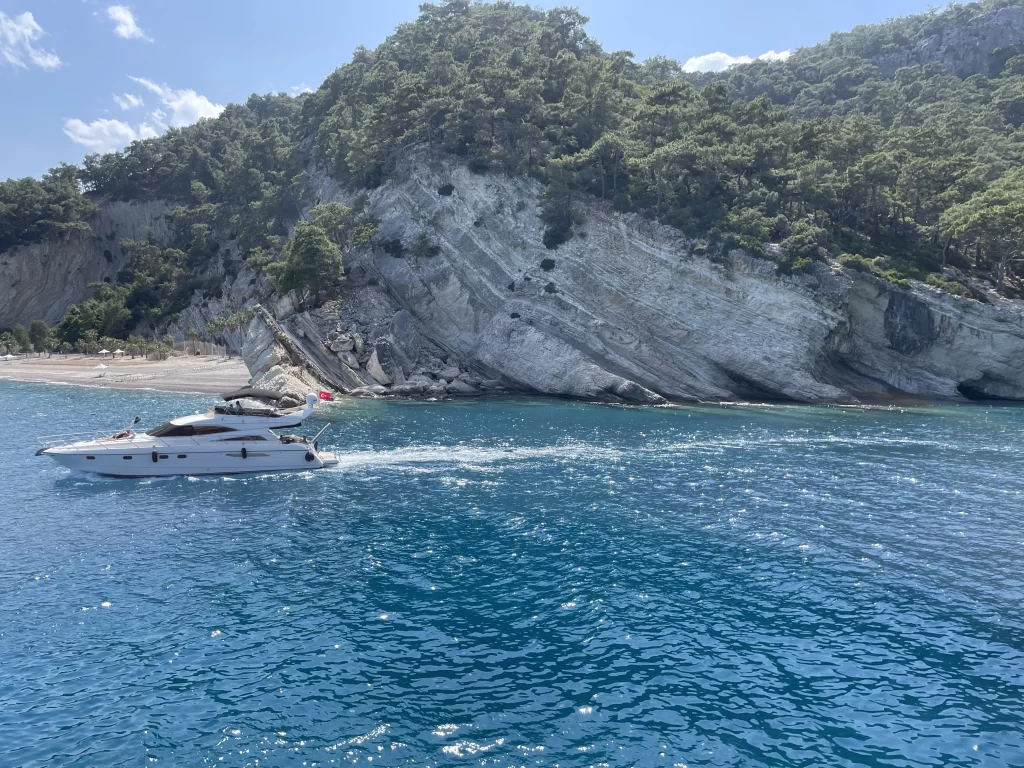
Konyaaltı Beach
Just a short drive from the city, Konyaaltı Beach is a pebble-lined paradise with calm, clear waters. What makes this spot great is the variety of activities nearby—from the Antalya Aquarium and Aqualand & Dolphinland to parks, cafés, and beachside restaurants. It’s the perfect choice for a relaxed, easygoing beach day, especially if you’re traveling with family.
Patara Beach
For something more untamed and scenic, I headed to Patara Beach, one of Turkey’s longest and most pristine shorelines. Stretching 18 km, this protected national park is a nesting site for loggerhead turtles, so it remains beautifully unspoiled. The soft golden sand, crystal-clear shallows, and majestic dunes make it feel almost surreal. Plus, the nearby ancient ruins of Patara add a layer of history that makes this place even more special.
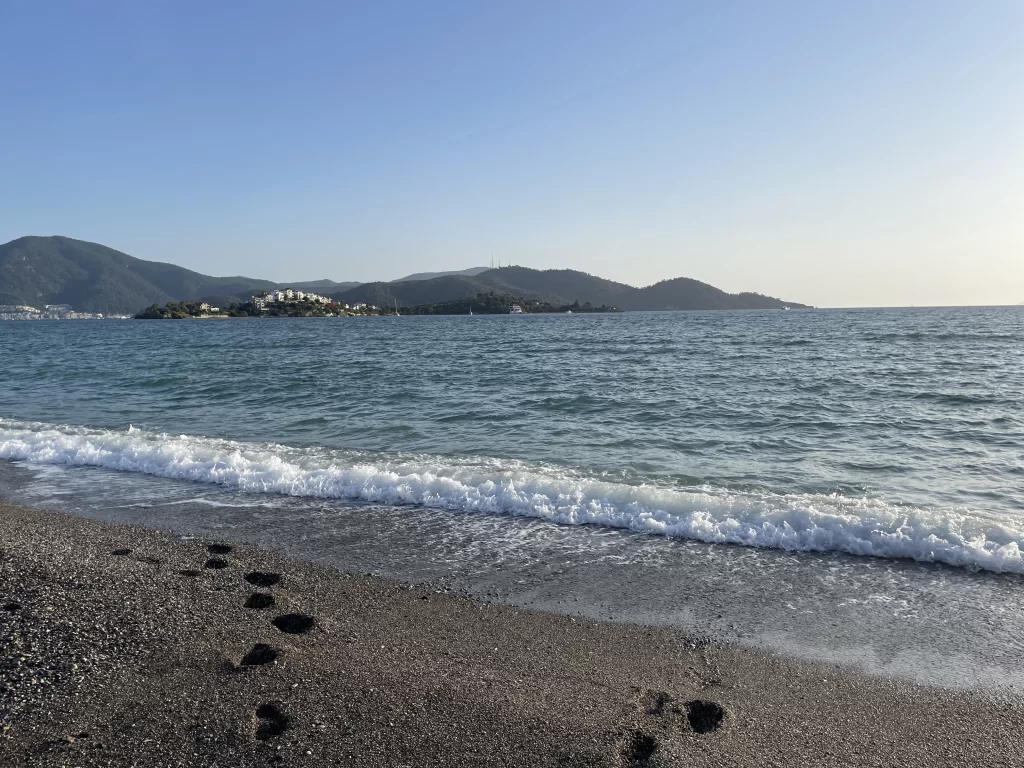
Kaputaş Beach
Tucked between the cliffs along the road between Kaş and Kalkan, Kaputaş Beach is the kind of place that makes you slam on the brakes just to take it all in. The first glimpse from the road is breathtaking—a turquoise bay framed by towering cliffs. Getting down requires a flight of stairs, but it’s worth every step. The beach itself is small but incredibly picturesque, with golden sand and impossibly blue water. Since facilities are limited, it’s best to bring everything you need for the day.
Day 9: Day Trip to Pamukkale
Visiting Pamukkale had been at the top of my Turkey bucket list, and seeing it in person was just as surreal as I had imagined. This otherworldly landscape, made up of white travertine terraces filled with mineral-rich pools, looks almost too magical to be real. While there’s still some mystery around how these terraces were formed, one thing is certain—they’re unlike anything else I’ve seen.
Pamukkale & Hierapolis – A Two-in-One Experience
Sitting right above Pamukkale is the ancient Greco-Roman city of Hierapolis, a place once famous for its healing hot springs. The Romans built an entire spa city here, and today, visitors get to explore both Pamukkale and Hierapolis with a single ticket.
- Entrance Fee: 25 TL (includes both sites)
- Cleopatra’s Pool (Optional Swim): 32 TL
- Turkish Museum Pass Holders: Free entry & queue skipping
Best Tips for Visiting
- Stay for the whole day. With one ticket, you have access from morning to sunset—so take your time.
- Bring swimwear if you plan to wade through the terraces or take a dip in Cleopatra’s Pool, where legend says Cleopatra herself once swam.
- Wear water shoes. Walking barefoot on the terraces is required, but some areas are slippery.
Pamukkale is one of those bucket-list places that truly lives up to the hype. Seeing the sun reflect off the brilliant white terraces, exploring the ancient ruins of Hierapolis, and even taking a dip in the same mineral-rich waters the Romans once bathed in—it was an unforgettable experience.
Day 10: Depart Home
I just wrapped up an amazing 10 day Turkey itinerary, where I experienced a mix of historical sites, sailing adventures, a cosmopolitan city, and the unique landscapes of Cappadocia.
I traveled using public transport, which was both safe and cost-effective, especially as a solo traveler.
I hope this guide serves as a helpful reference for your own trip! Remember, having more time allows you to visit additional places, but some spots, like Pamukkale, can be enjoyed in just one day.
Further Readings & Resources
New Jersey to Florida: 9 Ultimate New Jersey to Florida Road Trip Spots
San Francisco to Seattle: 10 Most Beautiful San Francisco to Seattle Road Trip Stops
Chicago to Niagara Falls: 9 Spectacular Chicago to Niagara Falls Road Trip Stops
Los Angeles to Yosemite: 9 Sensational Los Angeles to Yosemite Road Trip Stops
New York to Maine: 8 Spectacular Spots on New York to Maine Road Trip
